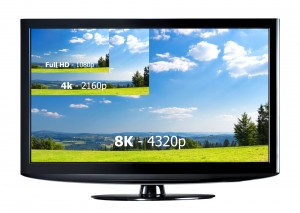UHD stands for Ultra High Definition and indicates the resolution of a display, like the more commonly known Full-HD. There are two forms of UHD; 4K and 8K. The best way to understand this is to reference it to Full HD, which is 1920 x 1080 resolution. (16:9 ratio)
From Full-HD to 4K the pixel count doubles and then it doubles again from 4K to 8K. To get a better understand of this, have a look at the picture below.
> 4K UHD resolution is 3840 x 2160.
> 8K UHD is even higher, at 7,680 x 4,320.
(Both 4K & 8K UHD are measured in a 16:9 aspect ratio – widescreen)
Not only is there more pixels, but the dynamic range of highlights and shadows are further enhanced in UHD over Full-HD. To better understand the jargon of screen sizes, display sizes are commonly referenced by their height (1080p (Full HD), 2160 (4K), 4320 (8K).
4K is the new frontier, with more and more content being made available everyday. There are even a number of affordable options for recording devices, including many DSLRs cameras and video cameras in the consumer market. Even the new iPhone 6 mobile phones are capable of recording 4K content.
With 8K video recording devices costing up to $20,000, content at this level is the next medium that will become the eventually become the norm, but this may be a little while off yet before is becomes at a consumer level. There is not a lot of content available at present. This, like a most new technology, this is mainly due to the prohibitive factor of cost.
If you have any questions about UHD or require assistance with your custom audio visual requirements contact a DIB Audio Visual Solutions Consultant today. Phone (03) 9457-4800 or contact us


